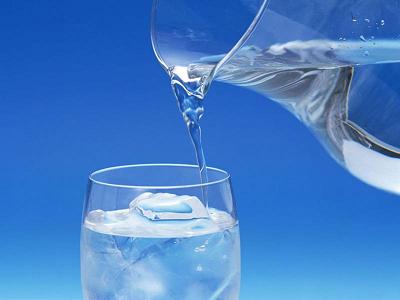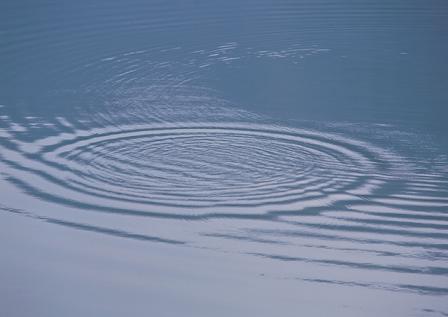WHAT WATER IS
AND HOW IT BEHAVES
|
| Water is not only the most common substance on Earth, it is also one of the most unusual. No other substance can do all the things that water can do. Water is an exception to many of nature's rules because of its unusual properties (qualities).
The chemistry of water.
Water consists of tiny particles called molecules. A drop of water contains many millions of molecules. Each molecule, in turn, consists of even smaller particles called atoms. Water molecules consist of atoms of hydrogen and oxygen. Hydrogen and oxygen by themselves are gases. But when two atoms of hydrogen combine with one atom of oxygen, they form the chemical compound H2O-water.
|

|
Even the purest water contains substances besides ordinary hydrogen and oxygen. For example, water contains very tiny portions of deuterium, a hydrogen atom that weighs more than the ordinary hydrogen atom. Water formed by a combination of deuterium and oxygen is called heavy water. Water is a combination of several different substances, but these substances make up only a small fraction of it.
The properties of water.
Water can be a solid, a liquid, or a gas. No other substance appears in these three forms within Earth's normal range of temperature. The molecules that make up water are always moving, and the form water takes depends on how fast they move. The molecules in solid water (ice) are far apart and almost motionless. The molecules in liquid water are close together and move about freely. The molecules in water vapor, a gas, move about violently and bump into one another.
Ice.
Most substances contract as they grow colder. But when water is cooled, it contracts only until its temperature reaches 39 °F (4 °C). Water expands when it becomes colder than 39 °F. For this reason, when ice forms at 32 °F (0 °C), it floats on liquid water. If water contracted upon freezing, any volume of ice would be heavier than an equal volume of liquid water. Ice would then sink. If ice sank, Earth would become a lifeless Arctic desert. Each winter, more and more ice would pile up on the bottom of lakes, rivers, and oceans. In summer, the sun's heat could not reach deep enough to melt the ice. Water life would die. The hydrologic cycle would slow down. In time, all of the water would turn to solid ice, except perhaps for a thin layer of water over the ice during the summer.

Liquid.
Water is a liquid at temperatures found in most places on Earth. No other common substance is liquid at ordinary temperatures. In fact, the temperatures at which water is a liquid are unusual. Water is a liquid between 32 °F (0 °C), its freezing point, and 212 °F (100 °C), its boiling point. But substances with a structure like that of water are not liquid in this temperature range. These substances include gases with the formulas H2Te, H2Se, and H2S. As their formulas show, they are closely related to water (H2O). Each has two atoms of hydrogen, plus an atom of the elements tellurium, selenium, or sulfur. If water behaved like these close relatives, it would be a liquid between about -148 °F (-100 °C) and -130 °F (-90 °C). In that case, there would be no liquid water on Earth because Earth's temperatures are far higher than -130 °F.
Water weighs about 62.4 pounds per cubic foot (1 kilogram per liter). Scientists compare the weight of other substances with the weight of water to find the specific gravity of the other substances
Vapor.
If an uncovered glass of water stands for a few days, the water will gradually disappear because the water molecules are moving constantly. Those at the surface break free of those below and enter the air as vapor. The higher the temperature of the water, the faster it evaporates, because the water molecules move faster.
Water can also be turned into vapor by boiling it, and creating steam. It takes an enormous amount of heat to produce steam. Water boils at 212 °F (100 °C). But when water reaches the boiling point, it does not immediately turn into steam. First there is a pause, during which the water absorbs additional heat without any rise in the temperature. This heat is called latent heat. More than five times as much heat is required to turn boiling water into steam as to bring freezing water to a boil. Thus, steam holds a great amount of latent heat energy. People use this energy to run machinery.
Water vapor in the air also holds a tremendous amount of latent heat energy. This energy is released when the vapor cools and condenses, and falls as rain. The high latent heat of water is related to water's remarkable heat capacity.
Heat capacity is the ability of a substance to absorb heat without becoming much warmer itself. Water has a greater heat capacity than any other substance except ammonia. To illustrate water's unusual heat capacity, imagine a pound of water, a pound of gold, and a pound of iron-all at -459.67 °F (-273.15 °C). This is absolute zero, the temperature at which a substance supposedly contains no heat at all. If all three substances were heated and each absorbed the same amount of energy, the gold would melt at 2016 °F (1102 °C). But the ice would still be at -300 °F (-184 °C). When the iron began to melt at 2370 °F (1299 °C), the ice would finally have reached 32 °F (0 °C).
Surface tension is the ability of a substance to stick to itself and pull itself together. Water's surface tension is extremely high. A dripping faucet shows how water sticks to itself. As the water drips, each drop clings to the faucet, stretches, lets go, and then snaps into a tiny ball. Water molecules cling together so tightly that water can support objects heavier than itself. For example, a needle or a razor blade can float on water. Insects can walk on water. Water can also stick to other substances, such as cloth, glass, and soil. By sticking to these substances, water wets them.
Capillarity is the ability of a liquid to climb up a surface against the pull of gravity. You can see water's climbing ability in a glass of water. The water is higher around the edges, where it touches the glass. The capillarity of water helps it circulate through soil, and up through the roots and stems of plants. It also helps circulate blood, which is mostly water, throughout our bodies.
Dissolving ability.
Water can dissolve almost any substance. It dissolves the hardest rocks as it runs over the land and seeps through the ground. In time, it carries the dissolved materials to the oceans. Water also dissolves the nutrients that all living things need. Water dissolves and carries the nutrients in the soil to plants and to the cells within plants. Water also dissolves the food that people and animals eat, and then carries this food to the cells.

How water is held together.
Water's unusual properties depend on the forces that hold it together. These forces are (1) chemical bonds and (2) hydrogen bonds.
Chemical bonds are the forces that hold the two hydrogen atoms and the one oxygen atom together in a water molecule. Each hydrogen atom has one electron whirling in orbit around its nucleus. But each of these atoms has room for two electrons. The oxygen atom has six electrons in its outer orbit, but it has room for eight. The hydrogen and oxygen atoms each fill their empty spaces by sharing their electrons. The two electrons from the two hydrogen atoms enter the orbit of the oxygen atom. At the same time, two electrons from the oxygen atom fill the empty spaces in the two hydrogen atoms. The resulting water molecule is an extremely tight structure.
|
Hydrogen bonds are the forces that link water molecules together. Water molecules have a lopsided shape because the two hydrogen atoms bulge from one end of the oxygen atom. The hydrogen end of the water molecule has a positive electric charge. At the opposite end, the molecule has a negative charge. Water molecules link together because the positive and negative charges attract. The positive ends of water molecules attach to the negative ends of other water molecules, whose positive ends attach to the negative ends of still other water molecules.
Contributor: Thomas M. Keinath, Ph.D., Dean, College of Engineering, Clemson University.
..: |
|



